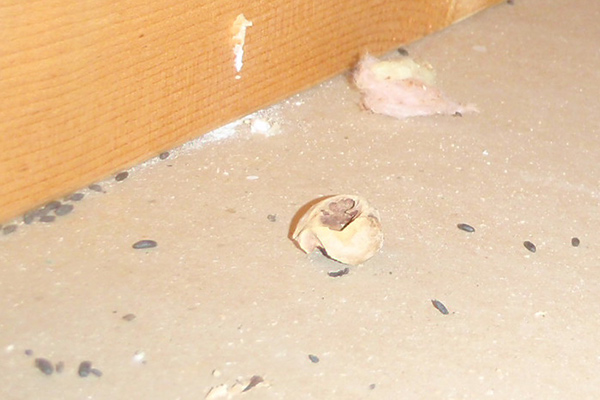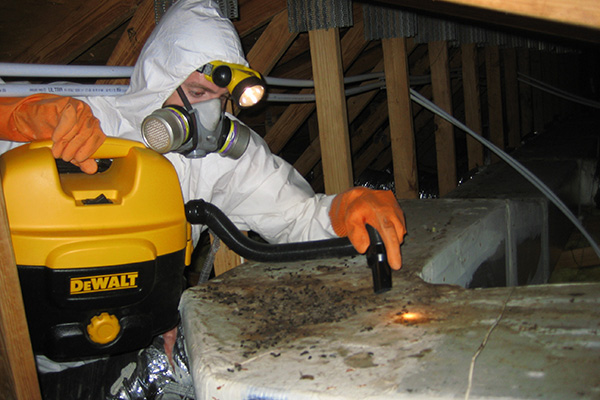- info@animalatticpest.com
- Call - we service 300 locations

Mouse Feces in the Attic - Photographs, How to Clean
Of course mice always deficate and urinate in the attic. This can cause odor problems, a breeding ground for mold, is
host to potential pathogens and health risks, and the odor can contain phermonones that attract other mice into the attic. Sometimes the feces or urine can leak through the drywall and onto your ceiling. I have
seen that many times. Be sure not to touch or even disturb mouse feces in an attic. It is often a good idea to clean it up, with a full attic restoration.
As for how to identify mouse feces (or droppings, poop, scat, turds, latrine, whatever you want to call it), look at the below photographs. The feces are small brown poops, about 1/8 inch in length on average, with
semi-pointed ends. They are usually scattered instead of in piles, and sometimes the droppings number in the thousands. They often become drier and thus more chalky in appearance with age, but are usually
pretty much dark brown, like your own poo.
Photographs of Mouse Feces in Attics
Mouse Feces with Nuts
Sometimes the feces are mixed with chewed nuts or other debris. This is a good clue that it's mice, especially if the nuts are small acords, like in these photos.
Mouse Droppings are Tiny
You can see that the feces are very small. The average size is about 1/8 inch, like a very small grain of rice. The ends are often a bit pointed, unlike round rat feces.
Here's a Mouse Tunnel in Insulation
Other clues can help you identify mouse fecal matter, such as the small size of this mouse tunnel in the insulation near the droppings. Only a mouse can fit there.
Information About Mouse Feces in the Attic
Mouse Feces
Before you can take steps to get mice out of your attic or another area of your home, you need to confirm that these are in fact the pests that are wreaking havoc. If you don’t actually catch a glimpse of them, you can use their droppings to identify mice as the culprits. Even if you have already spotted mice in your attic, you will need to know what health risks are associated with their waste and the proper way to go about cleaning it up.
How To Identify Them
The average mouse droppings will be skinny pellets with a diameter of about 1/16th of an inch and a length of around 3/16ths to ¼ inch. They may bulge slightly in the center and tend to have pointed tips. You will notice some variation in size, but those are averages. To put it simply, mouse feces tend to look like brown grains of rice that are smaller. The average mouse leaves 50 to 75 pellets every day so you can use their waste to estimate how many mice you have to remove from your attic.
What Else Might The Droppings Be?
Sometimes, other animals will leave behind droppings that you may mistake for those of mice. Rat droppings tend to be similar in shape to mouse droppings, but larger, perhaps 3/16th of an inch wide and half an inch long for roof rats with Norway rats having even larger droppings and rectangular ends. Squirrel droppings are a bit longer than mouse droppings, about 3/8 of an inch, and thicker, about 1/8 of an inch wide. They will also get lighter with age than mouse droppings. Chipmunk droppings are also similar in shape to but larger than mouse droppings. Bat droppings are perhaps the most commonly confused with mouse droppings. While mouse droppings are scattered, bat waste is closer together and they will be sparkly or slightly speckled and smell very different. If you aren’t sure whether the droppings are from a mouse, you can always consult an expert or compare them to photos.
Are They Fresh?
There are two main things to look at in order to tell whether the mouse droppings are fresh or not, color and consistency. Fresh mouse droppings tend to be so dark brown that they are close to black. They will get gradually lighter over the next few days meaning that light brown droppings are typically old. If you pick up the dropping with your gloved hands, you will notice that fresh droppings tend to be soft. If they crumble at all, this is a sure sign that they are old, although it isn’t a requirement.
Health Risks Of Mouse Feces
Part of the reason that you should know what to do about mouse feces is that these waste products can pose a serious health risk. In fact, there are more than 30 diseases linked to mice as well as their droppings. Just a few include Salmonellosis, Leptospirosis, Rickettsia virus, hemorrhagic fever, Lassa fever, rat bite fever, tularemia, and Eosinophilic Meningitis. Because of these health risks, you should always wear reliable gloves and at least a dust mask when coming close to the droppings. Preferably, you won’t even touch them directly through your gloves, instead using a vacuum, broom, or other object.
How To Clean Mouse Feces
Unfortunately, cleaning up mouse feces can be a great deal of work. You will have to remove as many as you can, but luckily you don’t have to do so by hand. You can vacuum up the droppings before thoroughly sanitizing the vacuum. Even so, you are likely going to need to physically pick up or sweep up at least a few of the droppings in areas the vacuum nozzle can’t reach. During cleanup, remember to also throw out anything that the mouse feces came into contact with. Pay close attention to the possibility of soiled insulation since mice tend to make nests in this cozy area.
After you get all of the mouse feces out of the attic or other area, you need to sanitize it as thoroughly as possible. In the case of a large infestation, you should use a fogging machine and enzymatic cleaner as this will ensure that the disinfectant reaches every nook and cranny in the attic. You can also use any strong disinfectant, including bleach mixed with water, but be sure that it is applied to every area where there were mice droppings or urine.
Remember to take safety precautions before cleaning the area. Wear gloves and a filter mask and always thoroughly wash your hands and arms afterwards. You can also make the process go much easier by simply hiring someone to take care of it. If your wildlife removal expert doesn’t take care of cleaning up mice droppings, they will know a company that does.
The Bottom Line of Mouse Poo
To identify the rodent feces in your attic, the best bet is to look at the size. Smaller is mouse, larger is rat or squirrel. How to get rid of mouse droppings in the attic - the best approach is a full cleanup, with either vacuuming of feces or insulation removal, and fogging of the attic with a special enzyme cleaner. But if your attic isn't too dirty, you may want to skip this expensive step. If you just have some poop in your attic and want to know which animal caused the poop, look at the above images of mouse droppings, and you should be able to identify if mice are the culprit.




